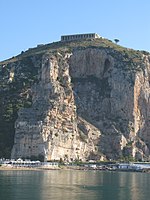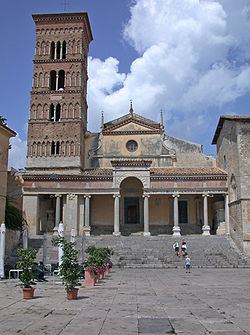Terracina
[3] The latter is the name of Jupiter himself as a youth (Iuppiter Anxur or Anxurus), and was the tutelary god of the city, venerated on the Mons Neptunius (current Monte S. Angelo), where a temple dedicated to him still exists (see below).An attempt was made in 184 BC to get round it (by censor Lucius Valerius Flaccus) on an embankment thrown out into the sea: but it was probably not until early in Trajan's time (98-117 AD) that a cut in the rocks at the foot of the promontory (Pisco Montano) finally solved the problem.[4] Terracina became an important centre for the development of the fertile valley lying to the west, and started to grow new settlements at the foot of the hill which turned into a sanctuary area with some patrician mansions.The nearby mineral springs by the coast, known to the Romans as Neptuniae aquae and later renamed Acqua Magnesia, are still in use, except one containing arsenic which was blocked up both by the ancients and again in 1839 as a precaution.However, after the crisis of papal authority in the following century, Terracina came to be ruled by local or Roman families (like that of Crescenzi, who built a massive castle, or the Frangipani, who occupied it from 1153 to 1202).The 1357 Costituzioni Egiziane ("Egyptian Constitutions") marked the beginning of a stronger papal authority, which however did not impede the growth of the king of Naples's influence, nor did it stop the city's internal struggles.The 16th century saw the communal freedoms steadily eroded, due both to the general decline of Terracina (aggravated by malaria in the increasingly marshy surrounding land) and the devastating attacks by pirates coming from North Africa.During the Napoleonic occupation Terracina was at first annexed to the Circeo département, but revolted in 1798: the riot was suppressed by French and Polish troops, led by general Étienne-Jacques-Joseph-Alexandre MacDonald.After the end of the Napoleonic Wars, the position of Terracina at the border between the Papal States and the Kingdom of Naples was officially set by the Concordat signed by Pope Pius VII and Ferdinand I of Two Sicilies in 1818.The Cosmatesque-inlaid vestibule is preceded by an eighteen-step staircase, and supported by ten ancient columns resting upon recumbent lions, with a mosaic frieze upon them, made by 12th century Sicilian-Norman artists.The summit of the promontory, elevation 227 metres (745 ft), is reached by the old line of the Via Appia, which is flanked by tombs and by remains of an ancient defensive wall with circular towers, the so-called Cinta Sillana (once attributed to Theodoric, but dating from the first decades of the 1st century BCE).The summit is occupied by a large terrace, supported by arcades of fine opus incertum (traditionally, but wrongly, called the "palace of Theodoric") on all sides except the east, with views seaward over the coast and over the Pontine Marshes.The cella was decorated internally with engaged half-columns, and contained the pedestal for the statue of the Jupiter, who would have been venerated here as a child-god: this attribution is confirmed by the discovery of numerous leaden votive figures, like those later made for dolls' houses, in the favissae on the east of the temple.Along these three km of the Via Appia are numerous ancient tombs, and the fertile valley to the northeast was thickly populated in Roman days,[4] before the intrusion of malaria.










AnxurusComuneCirceo promontoryRegionProvinceLatinaTime zoneSaint Caesarius of Terracinaprovince of LatinaVia AppiaVolscianJupiterIndo-EuropeanEtruscanTarquiniiVolscian HillsLepini MountainsPontine Marshestreaty between Rome and CarthageLatin leagueVolsciColoniacensorLucius Valerius FlaccusTrajanVia SeverianaLake of FondiSamnitessanctuarypatricianMarcus FavoniusCato the YoungerDomitianvillasAntoninus PiusarsenicGothic WarTheodoricLombardsEastern Roman EmpireDuchy of NaplesGeorge of NaplesPope John VIIICrescenziFrangipaniconclavecommunePope Honorius IIIPrivernoking of NaplesmalariaRenaissanceMadonna delle GraziePope Pius VICirceoÉtienne-Jacques-Joseph-Alexandre MacDonaldNapoleonic WarsPope Pius VIIFerdinand I of Two SiciliesGregory XVIprovince of RomeWorld War IIMonte San BiagioPontiniaSabaudiaSan Felice CirceoSonninofrazioniarched substructuresTerracina CathedralCesareoensconced within a temple of Roma and AugustusCosmatesqueSicilian-NormancampanileGothicRomanesqueConstantinopleAbbey of Fossanovaopus incertumCorinthian-ordertempleCapitoline TriadMinervaSophoclesLateran MuseumFeroniaSperlongaFrosinonemotorwayExeterList of twin towns and sister cities in ItalytwinnedBad Homburg vor der HöheCabourgJūrmalaMayrhofenMondorf-les-BainsRoman emperorpublic domainAshby, ThomasChisholm, HughEncyclopædia BritannicaOpenStreetMapWayback MachineComuniApriliaBassianoCampodimeleCastelforteCisterna di LatinaFormiaLenolaMaenzaMinturnoProssediRocca MassimaRoccagorgaRoccasecca dei VolsciSanti Cosma e DamianoSermonetaSpigno SaturniaVentotene